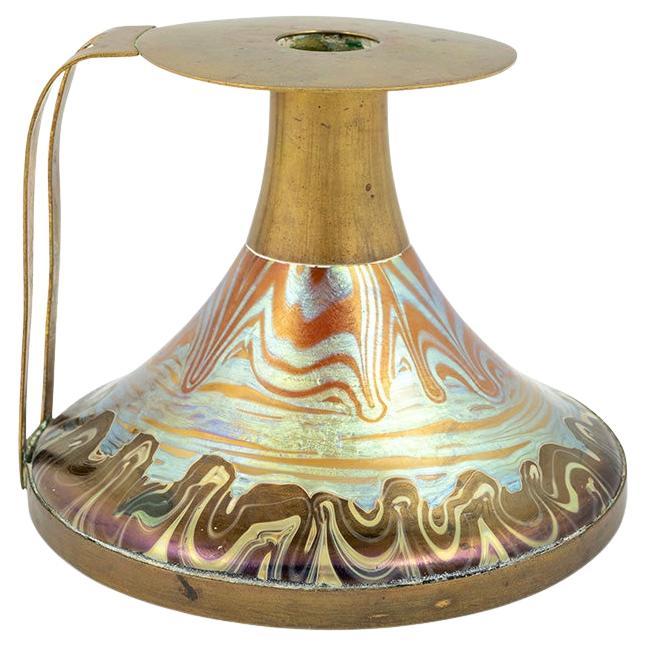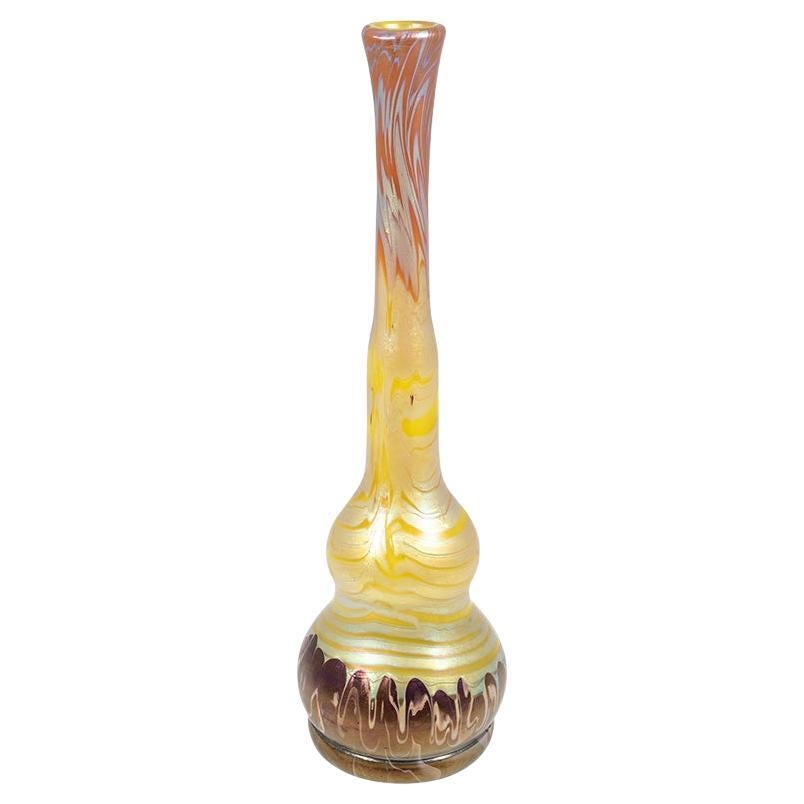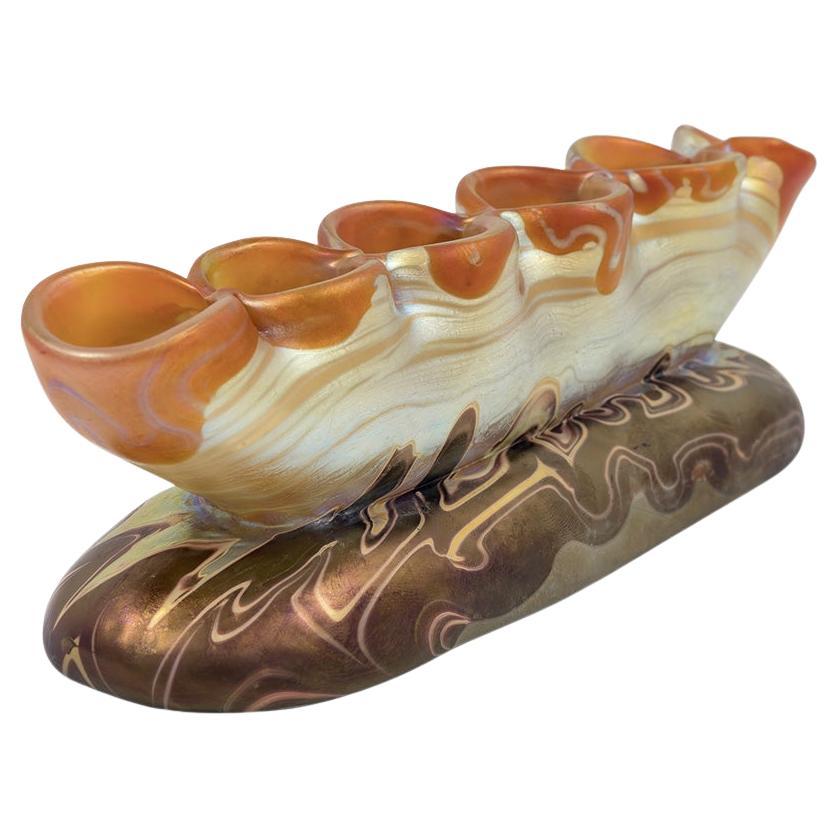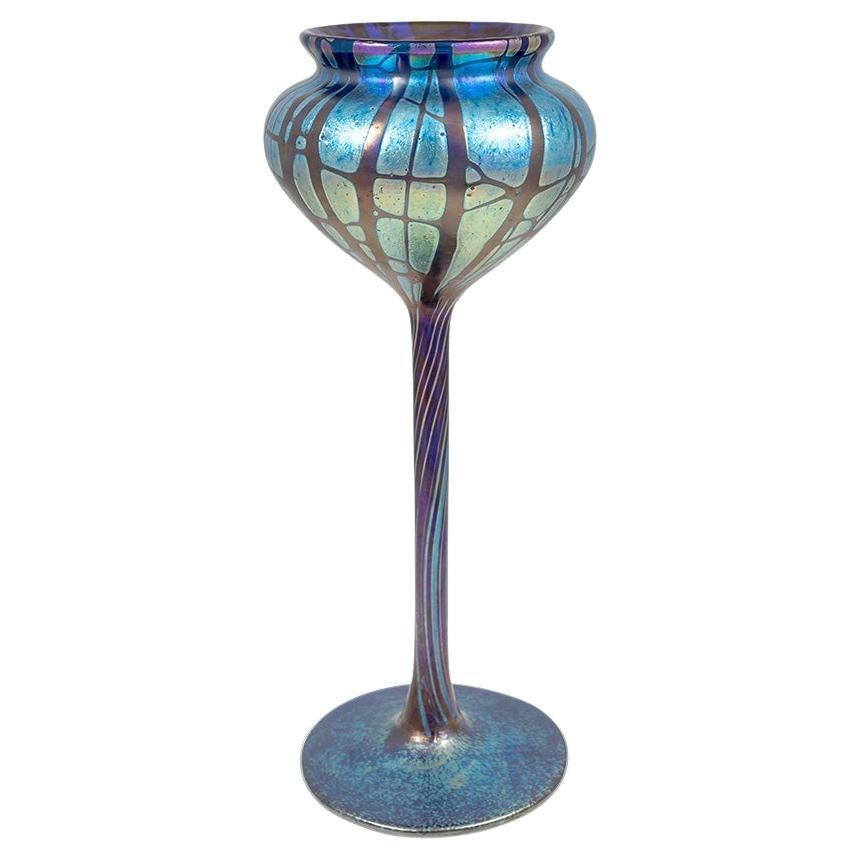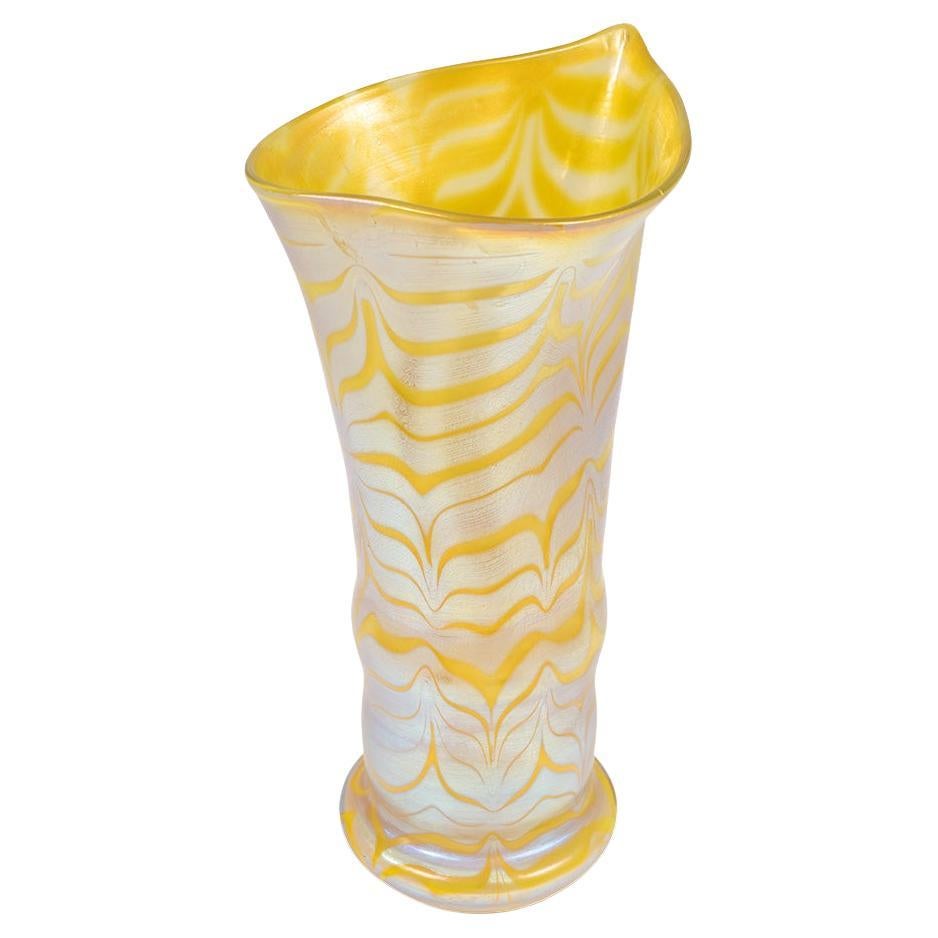Items Similar to Inkwell Loetz Art Noveau, circa 1900
Want more images or videos?
Request additional images or videos from the seller
1 of 10
Inkwell Loetz Art Noveau, circa 1900
About the Item
Inkwell Johann Loetz Witwe PG 358 decoration circa 1901
This inkwell with its PG 358 decoration is known from the world exhibition in Paris 1900. World exhibitions were an enormously important advertising factor for arts & crafts manufactories, as the audience for these events attended from all over the world. For the Loetz glassworks, it represented an important milestone in its company history. The inkwell is mould-blown, freeformed, reduced and iridescent and has a brass hinge.
- Creator:Loetz Glass (Manufacturer)
- Dimensions:Height: 2.56 in (6.5 cm)Diameter: 4.34 in (11 cm)
- Style:Jugendstil (Of the Period)
- Materials and Techniques:
- Place of Origin:
- Period:1900-1909
- Date of Manufacture:1900
- Condition:Wear consistent with age and use.
- Seller Location:Klosterneuburg, AT
- Reference Number:
About the Seller
5.0
Vetted Seller
These experienced sellers undergo a comprehensive evaluation by our team of in-house experts.
Established in 2013
1stDibs seller since 2021
13 sales on 1stDibs
Typical response time: <1 hour
- ShippingRetrieving quote...Ships From: Klosterneuburg, Austria
- Return PolicyA return for this item may be initiated within 14 days of delivery.
More From This SellerView All
- Colorful Candlestick Glass Loetz circa 1900 Austrian Art NoveauBy Loetz GlassLocated in Klosterneuburg, ATGlass Candlestick Johann Loetz Witwe PG 358 decoration circa 1901 This candlestick with its PG 358 decoration is known from the world exhibition in Paris 1900. World exhibitions wer...Category
20th Century Austrian Jugendstil Glass
MaterialsGlass
- Bohemian Glass Vase Loetz PG 358 circa 1900 Art NouveauBy Loetz GlassLocated in Klosterneuburg, ATAustrian Jugendstil glass vase manufactured by Johann Loetz Witwe, Phenomen Genre 358 decoration, circa 1900 This glass vase is an extraordinary example of the Loetz manufactory its...Category
Early 20th Century Austrian Jugendstil Glass
MaterialsGlass
- Bohemian Glass Vase Loetz PG 358 circa 1900 Art NouveauBy Loetz GlassLocated in Klosterneuburg, ATAustrian Jugendstil glass vase manufactured by Johann Loetz Witwe, Phenomen Genre 358 decoration, circa 1901 This glass vase is an extraordinary example of the Loetz manufactory its...Category
Early 20th Century Austrian Jugendstil Glass
MaterialsGlass
- Glass Centerpiece Loetz Austrian Jugendstil, circa 1900By Loetz GlassLocated in Klosterneuburg, ATAustrian Jugendstil glass centerpiece with six openings, Johann Loetz Witwe circa 1900 Phenomen Genre 358 decoration This glass centerpieces is an extraordinary example of the Loe...Category
Early 20th Century Austrian Jugendstil Glass
MaterialsGlass
- Bohemian Glass Vase Loetz circa 1900 Pampas Cobalt Art Nouveau BlueBy Loetz GlassLocated in Klosterneuburg, ATBohemian glass vase, manufactured by Johann Loetz Witwe, Pampas Cobalt decoration, ca. 1899, Blue, Silver, Viennese Art Nouveau, Jugendstil, Art Deco, art glass, iridescent glass. T...Category
Early 20th Century Austrian Jugendstil Glass
MaterialsGlass
- Bohemian Glass Vase Loetz circa 1900 Art Nouveau Jugendstil Yellow SignedBy Loetz GlassLocated in Klosterneuburg, ATBohemian glass vase, manufactured by Johann Loetz Witwe, Phenomen Genre 85/3780 decoration, signed, ca. 1900, Yellow, Silver, Viennese Art Nouveau, Jugendstil, Art Deco, art glass, i...Category
Early 20th Century Austrian Jugendstil Glass
MaterialsGlass
You May Also Like
- Vase Loetz , Style : Art Nouveau , Bohemia, circa 1900By Loetz GlassLocated in Ciudad Autónoma Buenos Aires, CLoetz The glass factory, originally founded in 1836 by Johann Baptist Eisner, was taken over. Loetz was the premier Bohemian glass works during this period. It was located in Klostermühle, near Rejštejn in the Sušice district in South-West Bohemia, which belonged to the Austro-Hungarian Empire until 1918. Susanna Loetz, widow of Glass entrepreneur Johann Loetz in 1852. She renamed the company "Glasfabrik Johann Loetz Witwe", a name that was retained until all activities were stopped in 1947. In 1879 it passed to Max Ritter von Spaun. Under his guidance, together with director Eduard Prochaska, the glassworks flourished as never before and enjoyed its most successful period. Von Spaun and Prochaska concentrated on the development of innovative glass types and new production techniques. Their first successful speciality was a glass type simulating semiprecious stones. It is often called "Marmoriertes Glas" ("marbled glass"). The range contained Onyx (red/brown), Karneol (red/pink) and later Malachit (green). It was introduced in the second half of the 1880's. From the same period dates the Octopus glass, of which the decor resembles the tentacles of a cephalopod. The production of Marmorier-tes Glas was resumed in 1906, in different colours like yellow and white. Octopus, 1885-1890, 1885-1890, unknown, an Malachit, 1885-1890, unknown, The master glass-blowers of Klostermühle had already carried out experiments with iridescence in the first half of the 1890's, and they produced the Olympia, a classically inspired olive green type, in 1896. Similar, in variants of creta green, bronce or Olympia and averse to any redundant decoration was the Glatt decor. It highly contrasted with the more elaborate finishes of that time, but it constitutes a part of the production with a deep sense for taste and quality. Most of the pieces shown in the "Glatt" decors were manufactured for Max Emmanuel in London. The glatt decor remained in use for many years. The Chiné decor had thin glass threads spun around the body in irregular patterns. It is not to be confused with the type of glass that was produced by Kralik. Loetz "Chiné" came in clear, opal, green and pink, Kralik "Chiné" in dark purple. The logical sequel to Chiné was the Pampas decor, green or cobalt blue, in which the threads almost disappeared in the surface, with iridised parts in between. Around the same time the dotted Papillon decor was introduced. The beautiful silver spots were employed on a wide array of models and quite effective on the gooseneck (water sprinkler) and sea shell...Category
Antique Early 1900s Austrian Art Nouveau Glass
MaterialsArt Glass
- Vase Loetz Widow Art Nouveau Phaenomen Gre Silver Overlay, circa 1900By Loetz GlassLocated in Vienna, ATVase Loetz Widow Klostermuehle Bohemia Art Nouveau Made by Loetz, Klostermühle circa 1900 Decor: PHAENOMEN GRE & Gorgeous Silver Overlay This finest Loetz Art Nouveau ...Category
Antique Early 1900s Austrian Art Nouveau Vases
MaterialsSilver
- Koloman Moser Art Nouveau Glass Pitcher by Loetz Witwe, Bohemia, 1900sBy Koloman Moser, Johann Lötz Witwe, Loetz GlassLocated in Vienna, ATA beautiful mouth blown Art Nouveau / Jugendstil glass pitcher, dated around 1900, designed by Vienna Secessionist Kolo Moser. This lovely jug is handmade of clear crystal glass and ...Category
Antique Early 1900s Czech Art Nouveau Glass
MaterialsCrystal
- Loetz Art Nouveau Vase Cobalt Papillon with Applied Butterflies, Ca 1900By Loetz GlassLocated in Vienna, ATFinest Bohemian Art Nouveau glass vase: Mould-blown vase with torus-shaped stand and funnel-shaped attached wall with trefoil-shaped, lobed mouth rim, wall and inside satin-finished, polished pontil. Shape: Production number / pattern not preserved Decor: Cobalt Papillon...Category
Antique Early 1900s Austrian Art Nouveau Glass
MaterialsGlass
- Antique American Art Nouveau Sterling Silver & Loetz Phaenomen Art Glass VaseBy Hartford Sterling Company, Loetz GlassLocated in Philadelphia, PAA fine Art Nouveau silver mounted art glass vase. Comprising a Loetz Phaenomen glass body in yellow with a silvery-blue iridescence and an Art Nouve...Category
Early 20th Century Jugendstil Vases
MaterialsSterling Silver
- Loetz Glass Art NouveauBy Loetz GlassLocated in Buenos Aires, ArgentinaLoetz Glass Art Nouveau Origin Austria Circa 1920 Blue leaves and flowers motif with white background perfect condition. Art nouveau, modernist art or modernism was an international ...Category
Vintage 1920s Austrian Art Nouveau Glass
MaterialsArt Glass
Recently Viewed
View AllMore Ways To Browse
Venini Ambasciata
Baccarat Dresser Set
Carnival Glass Bowls
Hawkes Goblets
Venetian Finger Bowls
Antique Pink Crystal Goblets
Baccarat Vanity Set
Bohemian Rare Set Gilded Glasses
Cenedese Tumbler
Covered Compote From Early 19th Century
Cranberry Wine Hock
Daum Claret
Hand Blown Green Liqueur Glasses
Moser Hamilton
Moser Lady Hamilton
Pink Champagne Salviati
Teal Tumblers
Thomas Webb & Sons On Sale
